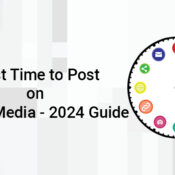07/23/2021
/
Difference Between Featured Snippet, Rich Snippet, Rich Answers, and Knowledge Graph
Google is getting more user-centered to display accurate Search Engine Result Pages (SERPs) and has introduced SERP features. However, SERP features like the Knowledge Graph, Rich Answers, Rich Snippet, Featured Snippet, and PPC Ads are affecting organic search results as people are getting answers to their queries instantly. A number of buzz words are thrown around in SEO space, and with so many things to remember, confusion pervades. Let’s talk about each one of them one by one.
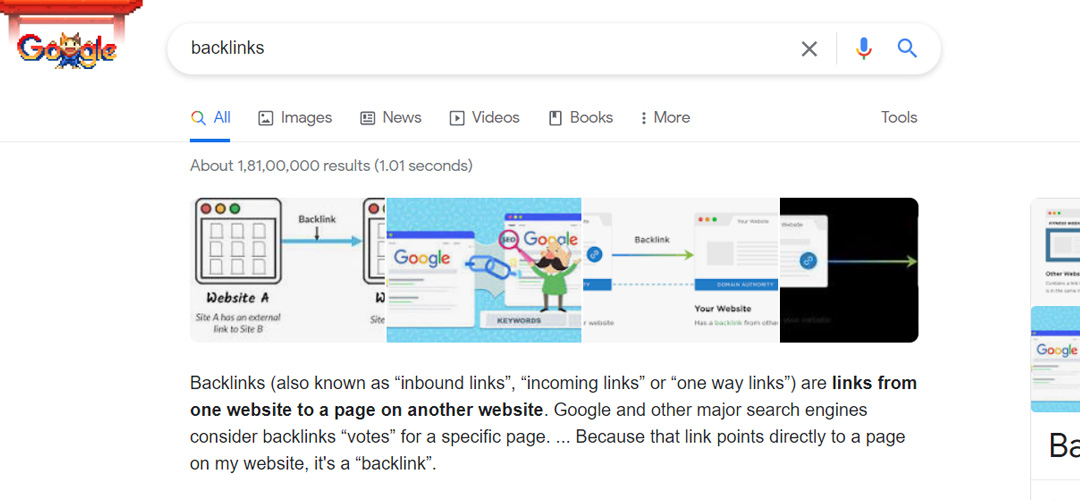 Intended to provide the best user experience and answer searchers' queries appropriately, Google came up with a featured snippet. A featured snippet refers to the ‘zero position’ that a search occupies wherever a search query is raised.
These featured snippets tend to steal more than 10-20% of traffic as these provide direct and accurate answers to queries along with source links. Optimizing your content or website for the featured snippet helps Google decide what makes your content worthy of being displayed as featured snippets. It shows results that are highly pertinent and can be a possible option that the user wants to see without an in-depth dive.
Mainly, we can see four types of featured snippets.
Intended to provide the best user experience and answer searchers' queries appropriately, Google came up with a featured snippet. A featured snippet refers to the ‘zero position’ that a search occupies wherever a search query is raised.
These featured snippets tend to steal more than 10-20% of traffic as these provide direct and accurate answers to queries along with source links. Optimizing your content or website for the featured snippet helps Google decide what makes your content worthy of being displayed as featured snippets. It shows results that are highly pertinent and can be a possible option that the user wants to see without an in-depth dive.
Mainly, we can see four types of featured snippets.
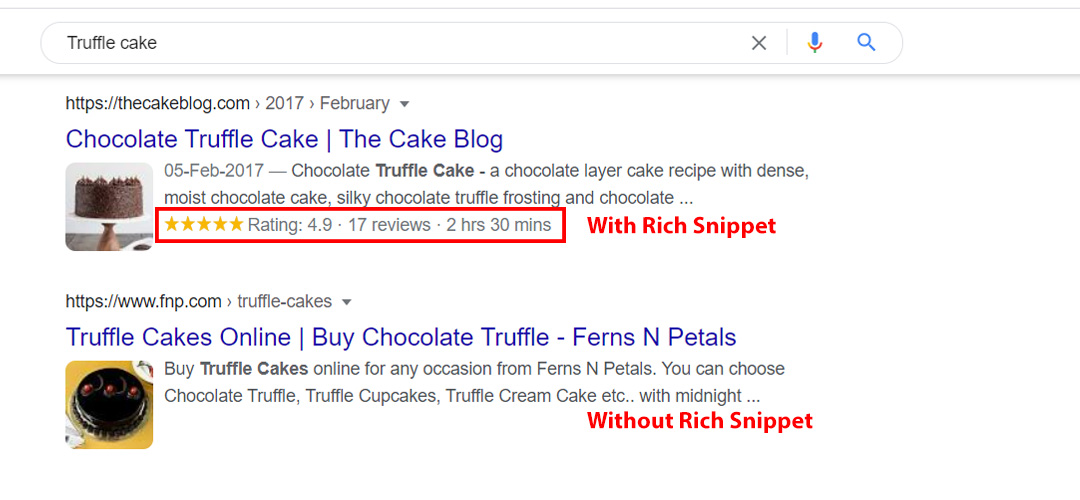 *Don’t confuse rich snippets with featured snippets; both are different*
Just another regular snippet in SERP, Rich Snippet, is a snippet that displays additional information alongside the title, descriptive snippet, and URL. The details that it showcases include events’ dates, reviews, ratings, etc. ‘This additional information prompts users to click on your link to learn more.
A product with 4 star-rating is preferred over one with 2 stars or no stars. Rich snippets appear for pages that display certain types of information, say “How to” queries, and the visibility of queries in rich snippets is often limited to devices. When it comes to the appearance of rich snippets, these elements are quite appealing, and the extra information in these snippets is extracted from structured markup.
*Don’t confuse rich snippets with featured snippets; both are different*
Just another regular snippet in SERP, Rich Snippet, is a snippet that displays additional information alongside the title, descriptive snippet, and URL. The details that it showcases include events’ dates, reviews, ratings, etc. ‘This additional information prompts users to click on your link to learn more.
A product with 4 star-rating is preferred over one with 2 stars or no stars. Rich snippets appear for pages that display certain types of information, say “How to” queries, and the visibility of queries in rich snippets is often limited to devices. When it comes to the appearance of rich snippets, these elements are quite appealing, and the extra information in these snippets is extracted from structured markup.
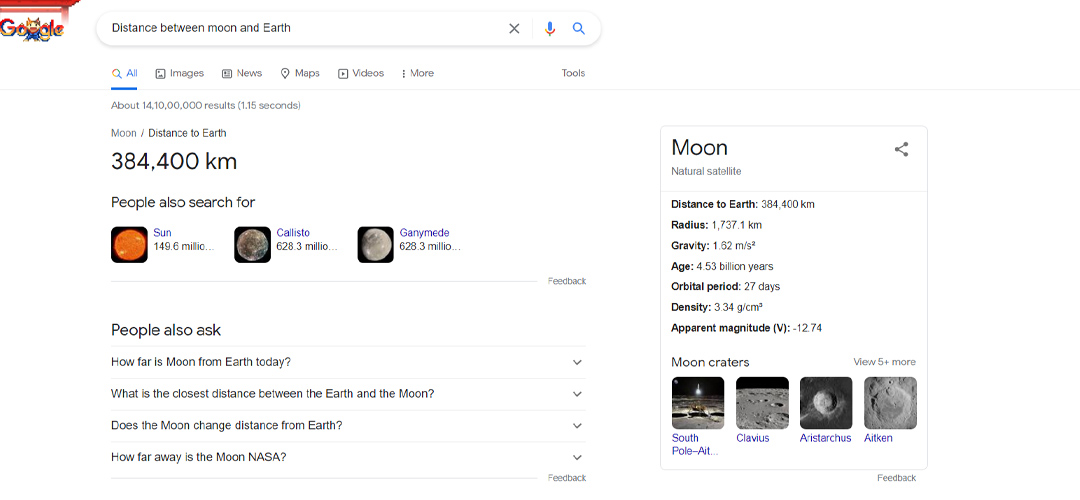
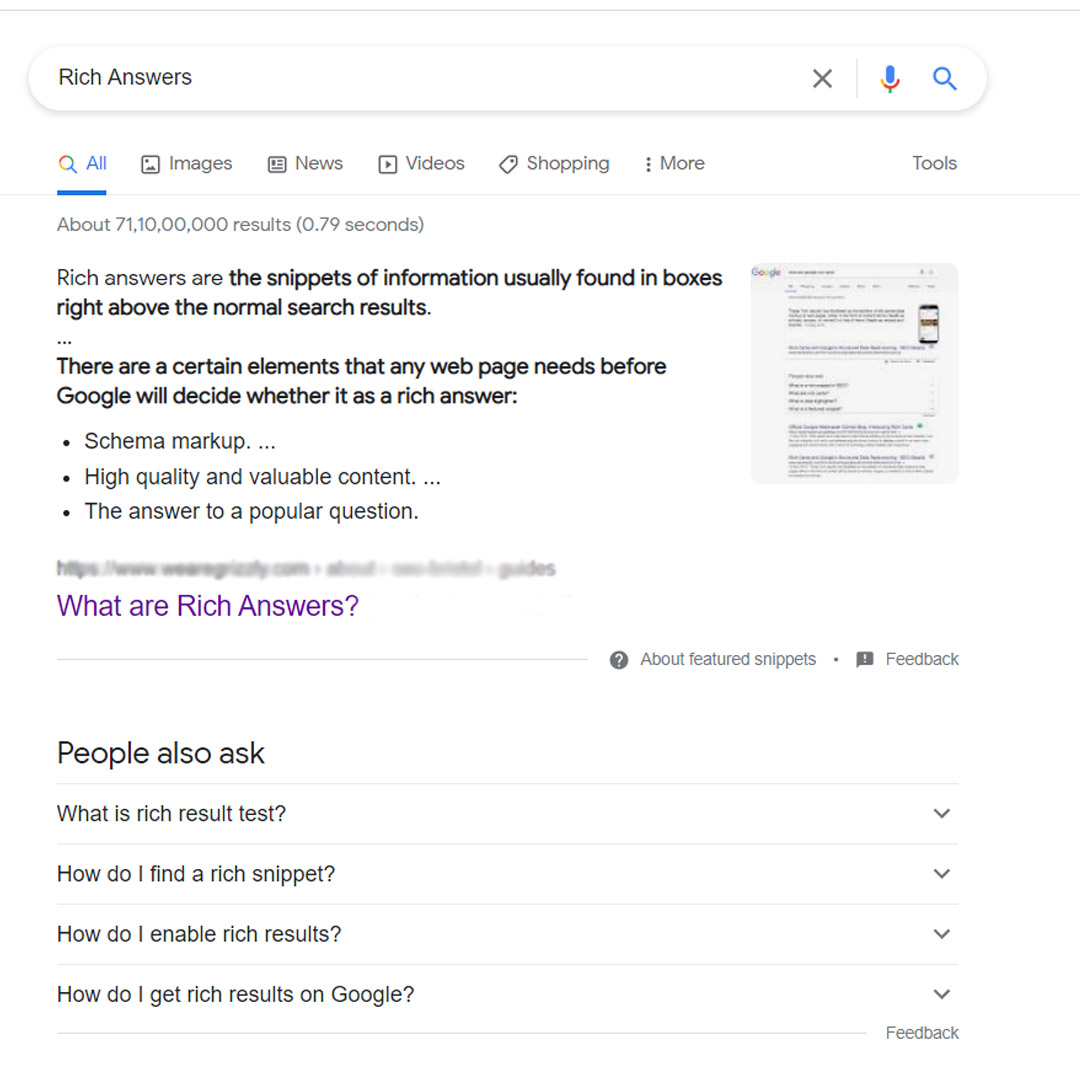 A rich answer is a click-free attempt by Google to provide relevant and quick answers to searchers' queries. Technically, these rich answers are like regular snippets displaying information in boxes on the top of SERP. The information is pulled from relevant sources or websites that rank high on search engines. A comprehensive extract taken from a website is used in the form of structured data markup to tell Google what and how to display it. Featured snippets are the best type of rich snippets as they contain relevant information.
A rich answer is a click-free attempt by Google to provide relevant and quick answers to searchers' queries. Technically, these rich answers are like regular snippets displaying information in boxes on the top of SERP. The information is pulled from relevant sources or websites that rank high on search engines. A comprehensive extract taken from a website is used in the form of structured data markup to tell Google what and how to display it. Featured snippets are the best type of rich snippets as they contain relevant information.
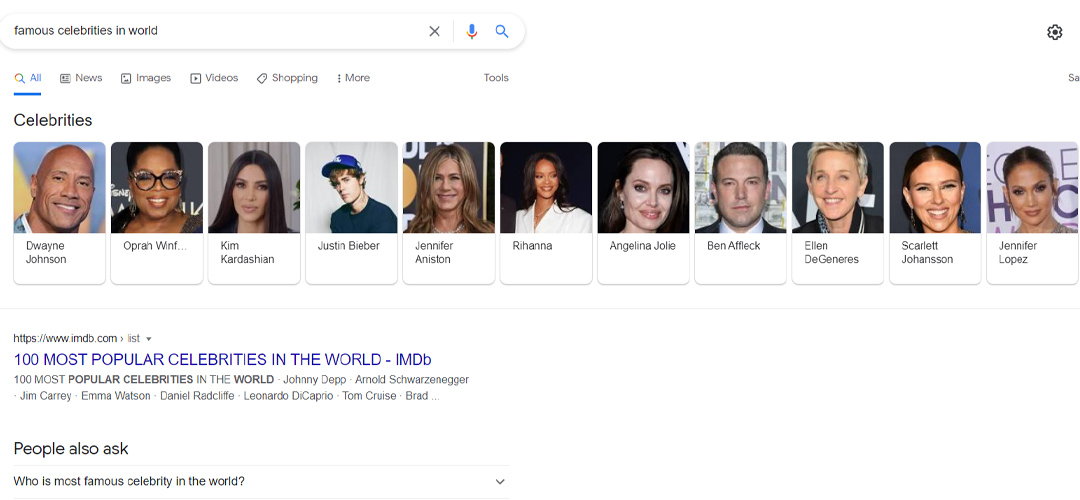 The Knowledge Graph is the easiest way to discover and surface publicly known and factual information without clicking. It provides a framework for unification, data integration, and analytics and sharing.
In particular, the “knowledge graph” is a database that contains plentiful data having frequently searched keywords along with their search intent on WWW.
It’s an interconnected channel that can be used to get information linked to the other. For instance, if you search for a movie but you don’t know the names of any of its characters. But you know that the villain is cast in some other movie with a “particular” name. You can simply search for it, and the knowledge graph will show all its cast to let you link and find the movie you were searching for.
The Knowledge Graph is the easiest way to discover and surface publicly known and factual information without clicking. It provides a framework for unification, data integration, and analytics and sharing.
In particular, the “knowledge graph” is a database that contains plentiful data having frequently searched keywords along with their search intent on WWW.
It’s an interconnected channel that can be used to get information linked to the other. For instance, if you search for a movie but you don’t know the names of any of its characters. But you know that the villain is cast in some other movie with a “particular” name. You can simply search for it, and the knowledge graph will show all its cast to let you link and find the movie you were searching for.
Featured Snippet
 Intended to provide the best user experience and answer searchers' queries appropriately, Google came up with a featured snippet. A featured snippet refers to the ‘zero position’ that a search occupies wherever a search query is raised.
These featured snippets tend to steal more than 10-20% of traffic as these provide direct and accurate answers to queries along with source links. Optimizing your content or website for the featured snippet helps Google decide what makes your content worthy of being displayed as featured snippets. It shows results that are highly pertinent and can be a possible option that the user wants to see without an in-depth dive.
Mainly, we can see four types of featured snippets.
Intended to provide the best user experience and answer searchers' queries appropriately, Google came up with a featured snippet. A featured snippet refers to the ‘zero position’ that a search occupies wherever a search query is raised.
These featured snippets tend to steal more than 10-20% of traffic as these provide direct and accurate answers to queries along with source links. Optimizing your content or website for the featured snippet helps Google decide what makes your content worthy of being displayed as featured snippets. It shows results that are highly pertinent and can be a possible option that the user wants to see without an in-depth dive.
Mainly, we can see four types of featured snippets.
- The Definition Box or paragraph snippet provides a straightforward and concise description.
- The Tabular form which displays a clear and comprehensive table
- The Ordered List for queries that need a set of steps to rank specific things in order.
- The Unordered List helps Google to present a list of items that have no order.
How to Optimize Your Content for Featured Snippet?
Optimizing for featured snippets would let the information stand a chance to appear in the featured snippet. All you need to do is format your content accordingly.- Perform keyword research and focus on a particular question.
- Proper formatting in any of the above-mentioned formats.
- Accurate answers that match your searcher’s query.
- Justify your content and create sections of information.
Rich Snippet
 *Don’t confuse rich snippets with featured snippets; both are different*
Just another regular snippet in SERP, Rich Snippet, is a snippet that displays additional information alongside the title, descriptive snippet, and URL. The details that it showcases include events’ dates, reviews, ratings, etc. ‘This additional information prompts users to click on your link to learn more.
A product with 4 star-rating is preferred over one with 2 stars or no stars. Rich snippets appear for pages that display certain types of information, say “How to” queries, and the visibility of queries in rich snippets is often limited to devices. When it comes to the appearance of rich snippets, these elements are quite appealing, and the extra information in these snippets is extracted from structured markup.
*Don’t confuse rich snippets with featured snippets; both are different*
Just another regular snippet in SERP, Rich Snippet, is a snippet that displays additional information alongside the title, descriptive snippet, and URL. The details that it showcases include events’ dates, reviews, ratings, etc. ‘This additional information prompts users to click on your link to learn more.
A product with 4 star-rating is preferred over one with 2 stars or no stars. Rich snippets appear for pages that display certain types of information, say “How to” queries, and the visibility of queries in rich snippets is often limited to devices. When it comes to the appearance of rich snippets, these elements are quite appealing, and the extra information in these snippets is extracted from structured markup.
Some common Rich Snippets in search results are:
- Recipe Snippet- A quick way to know the cooking time, ingredients and calories of a particular recipe.
- Movie Snippet- A detailed snippet that reveals information about the movie on a whole - the release date, director, cast, run time, and box office revenue, plus ratings.
- Events Snippet- Event highlights that contain important details about the event’s time, date, and location are revealed through the event snippet.
- Music Snippet- Music genre, album, release date, singers, lyricist, and everything else you want to know is revealed through a music-rich snippet.
- Review Snippet- Noticed that star- rating under description?
- Product Markup Snippet- Product markup is picked to display relevant product information including price, reviews, and availability and is found more often for eCommerce sites.
How to Optimize Your Content for Rich Snippets?
To optimize your content for the rich snippet, you need to use schema markup. Inform Google about the information that you want to be displayed by tagging your products with schema alerts to display your final content with additional information.Rich Answers

 A rich answer is a click-free attempt by Google to provide relevant and quick answers to searchers' queries. Technically, these rich answers are like regular snippets displaying information in boxes on the top of SERP. The information is pulled from relevant sources or websites that rank high on search engines. A comprehensive extract taken from a website is used in the form of structured data markup to tell Google what and how to display it. Featured snippets are the best type of rich snippets as they contain relevant information.
A rich answer is a click-free attempt by Google to provide relevant and quick answers to searchers' queries. Technically, these rich answers are like regular snippets displaying information in boxes on the top of SERP. The information is pulled from relevant sources or websites that rank high on search engines. A comprehensive extract taken from a website is used in the form of structured data markup to tell Google what and how to display it. Featured snippets are the best type of rich snippets as they contain relevant information.
Types of Rich Answers
These instant answers are shown without site credits, i.e., you see the answers without having to click on a particular site. It focuses on revealing factual data. This feature is meant to counter the need for fast, relevant content. The information that it discloses is related to the following-calculators, sliders, stock graphs, sports scores, maps, step-by-step directions, text-based answers, recipes, and so on.How Google chooses Rich Answers?
There are certain elements that Google looks for while choosing Rich Answers.- Schema markup, an essential to get the page considered for the rich answer. This is how developers disclose more information about the site on the backend.
- Exceptional content that answers or addresses queries are eligible to qualify for rich answers. Look for unique and organically created content to improve your chances of getting it approved.
- Popular questions are often picked for Rich Answers. So make sure you address the question that is asked more rapidly. Focusing on the searched questions is the best way to optimize your content for rich answers.
Knowledge Graph
 The Knowledge Graph is the easiest way to discover and surface publicly known and factual information without clicking. It provides a framework for unification, data integration, and analytics and sharing.
In particular, the “knowledge graph” is a database that contains plentiful data having frequently searched keywords along with their search intent on WWW.
It’s an interconnected channel that can be used to get information linked to the other. For instance, if you search for a movie but you don’t know the names of any of its characters. But you know that the villain is cast in some other movie with a “particular” name. You can simply search for it, and the knowledge graph will show all its cast to let you link and find the movie you were searching for.
The Knowledge Graph is the easiest way to discover and surface publicly known and factual information without clicking. It provides a framework for unification, data integration, and analytics and sharing.
In particular, the “knowledge graph” is a database that contains plentiful data having frequently searched keywords along with their search intent on WWW.
It’s an interconnected channel that can be used to get information linked to the other. For instance, if you search for a movie but you don’t know the names of any of its characters. But you know that the villain is cast in some other movie with a “particular” name. You can simply search for it, and the knowledge graph will show all its cast to let you link and find the movie you were searching for.
How does Knowledge Graph collect facts?
The source of this fact is not limited to one. It uses plenty of sources to compile factual information. Facts related to weather forecasts, stock prices, and sports scores etc. are revealed through this feature. This information may get sourced from knowledge panels directly from content owners.How does Google alter information on Knowledge Graph?
The credit goes to automation. With over thousands of searches processed every day, automating systems and search algorithms is the last resort. Though the size and scope of the information presented on Google are quite high, collecting the right information can be tricky. This increases the reliance upon public reporting systems. Data is collected from public reporting systems and undergo thorough analysis to eliminate content that infringes policies. This can be done both manually and automatically, especially on the topics that interest the public.Wrap Up
Now that the difference is clear, it may conclude that each one of these serves a different yet important function. For further queries, write us.Recent Posts
Monika Narriya/0 Comments
Why are ERP solutions important in the education sector?
Monika Narriya/0 Comments
Which is the best ERP solution provider company?
Monika Narriya/0 Comments
How do we select the right ERP solution for our businesses?
Sumit Kumar/0 Comments
9 Most In-Demand Programming Languages for 2024
Sumit Kumar/0 Comments
Best Time to Post on Social Media – 2024 Guide
Sumit Kumar/0 Comments
Why You Should Consider Semantic HTML for SEO
All Categories
- Bing
- Blockchain
- Blog
- Branding
- Case Study
- Content Marketing
- Conversion Rate Optimization
- Cryptocurrency
- Digital Currency
- Digital Marketing
- Email Marketing
- ERP Solutions
- Facebook Marketing
- Google Ads
- Google Updates
- Graphic Designing
- Hire Developers
- Image SEO
- Influencer Marketing
- IT
- Local SEO
- Machine Learning
- Mobile Application Development
- Pay Per Click
- Pinterest SEO
- Podcast Hosting
- React JS
- Reddit & Quora
- Search Engine Optimization
- SEO Copywriting
- Social Media Marketing
- Software
- Software Development
- Technology
- UX and UI
- Web Designs
- Web Hosting
- Website Development
- Website Redesigning
- YouTube SEO







